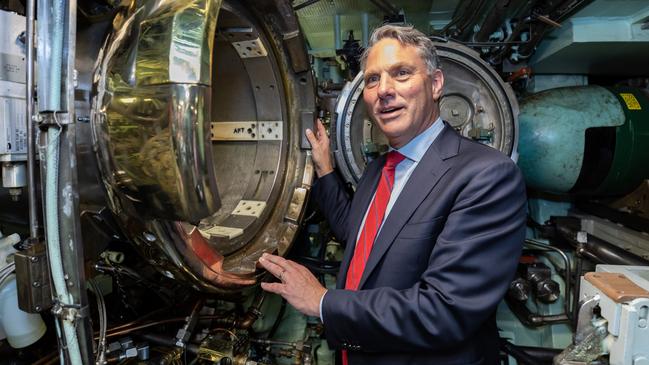Labor’s defence disconnect leaves nation guarded by a ‘paper ADF’: Australian Strategic Policy Institute’s warning
Labor’s focus on future military capabilities and its ‘business as usual’ defence budget will leave Australia with a ‘paper ADF’ that is ill-prepared for near-term conflict, a new report warns.

Labor’s focus on future military capabilities and its “business as usual” defence budget will leave Australia with a “paper ADF” that is ill-prepared for near-term conflict, a new report warns.
The Australian Strategic Policy Institute says the prioritisation of long-term defence programs such as AUKUS has come at the expense of present-day readiness, leaving a hollowed-out force with limited munitions stockpiles and a shortage of critical capabilities including missile defence systems and long-range weapons.
The think tank warns in its Cost of Defence report that there is a disconnect between the urgency of emerging threats and the timelines of major equipment purchases that won’t be delivered for a decade or more.
The report, to be released on Thursday, follows the government’s March budget that left defence spending languishing at about 2 per cent of GDP, despite fears of a potential US-China conflict before 2030, and pressure from the Trump administration to lift military spending to 3 per cent of national output.
The ASPI report, by former Home Affairs deputy secretary Mark Ablong, says while the government claims to have made a “generational investment” in Australia’s defence, “that investment has been put off for another generation”.
Citing Defence Minister Richard Marles’ oft-repeated declaration that the government has “no greater responsibility” than defending the nation, the report declares: “The failure of this year’s budget to meet that responsibility will make all Australians less secure.”
“While consistency can often be a virtue, it reveals a business-as-usual approach to a world now in crisis and conflict,” it says.
“The rhetoric recognising the threats isn’t translating into action to deal with the threats, meaning the government continues to deprioritise the readiness and sustainability of the current force-in-being.”
Mr Ablong argues the “slow pace” of procuring key systems including missile defence systems and long-range weapons “risks leaving the ADF ill-prepared for current threats and unable to keep pace with future challenges, creating a ‘no man’s land’ of preparedness”.
He says other Indo-Pacific nations are rearming “much faster than us”, with China’s aggressive military expansion raising the “real possibility” of a regional or global armed conflict in the next five years.
The budget brought forward just $1bn worth of spending, despite the ballooning cost of the AUKUS program, which won’t deliver a meaningful nuclear submarine force for at least a decade or more.
The first of the navy’s Hunter-class frigates isn’t due to enter service until the mid-2030s, while an accelerated build-program for new general purpose frigates promises a first ship by the end of the decade.
“While those future capabilities are strategically important, they offer little immediate enhancement, thus creating a ‘paper ADF’ that lacks readiness for near-term conflict scenarios,” the report says.
“That prioritisation of future over current readiness contributes to a hollowing out of the force, in which personnel shortages and limited munitions stockpiles exacerbate sustainability concerns.”
Mr Ablong says the government’s program to manufacture guided weapons in Australia is also progressing too slowly, leaving Australia vulnerable if supply chains come under threat.
He argues that the Defence Department is part of the problem, with an overly bureaucratic and top-heavy structure that has undermined accountability and agile decision-making.
He says “bureaucratic, risk-averse procurement processes” are delaying the acquisition of major weapons systems, and undermining the nation’s defence industry, “which is becoming increasingly frustrated at cancelled, reprioritised and delayed defence procurements”.
At the same time, the ADF workforce is facing ongoing recruitment and retention difficulties, impairing its ability to crew ships and maintain equipment.
The report follows the circumnavigation of Australia by three Chinese warships earlier this year, which conducted a surprise live-weapons drill the Australian government was alerted to by a Virgin Australia pilot.
Mr Ablong says the flotilla’s mission was to conduct rehearsed strikes on Australian cities, national infrastructure and joint Australia-US facilities.
The ASPI report follows a chorus of similar warnings by defence strategists, who say the government’s claims to massive increases in defence spending are massively overblown.
A report by defence analyst Marcus Hellyer in April argued real military spending was barely keeping up with inflation in a “remarkably lackadaisical” effort by the government.
The government rejects such analysis, using the inevitable year-on-year rise in the Defence budget to claim “record” military spending. “Our government has been engaged in the biggest peacetime increase in Australia’s defence spending since the end of the Second World War,” Mr Marles said after the budget.
The ASPI report follows the government’s move to clip the government-funded think tank’s wings with tighter funding rules and increased oversight of the organisation by the bureaucracy.
In his forward to the 154-page paper, ASPI director Justin Bassi said the organisation’s charter required it to provide objective advice to the government.
“It’s never been more important … to speak truth to power frankly and fearlessly,” he said.





To join the conversation, please log in. Don't have an account? Register
Join the conversation, you are commenting as Logout